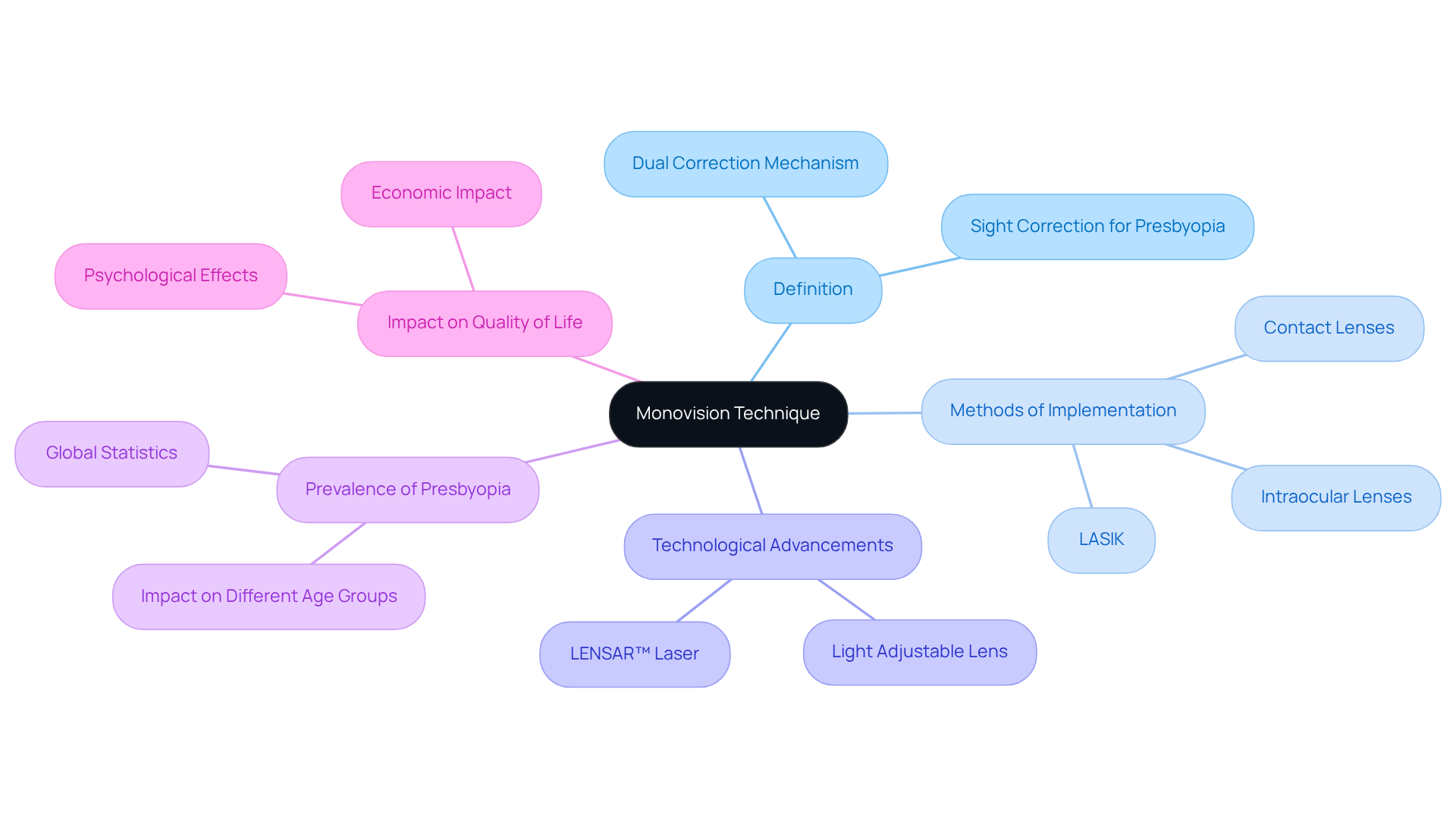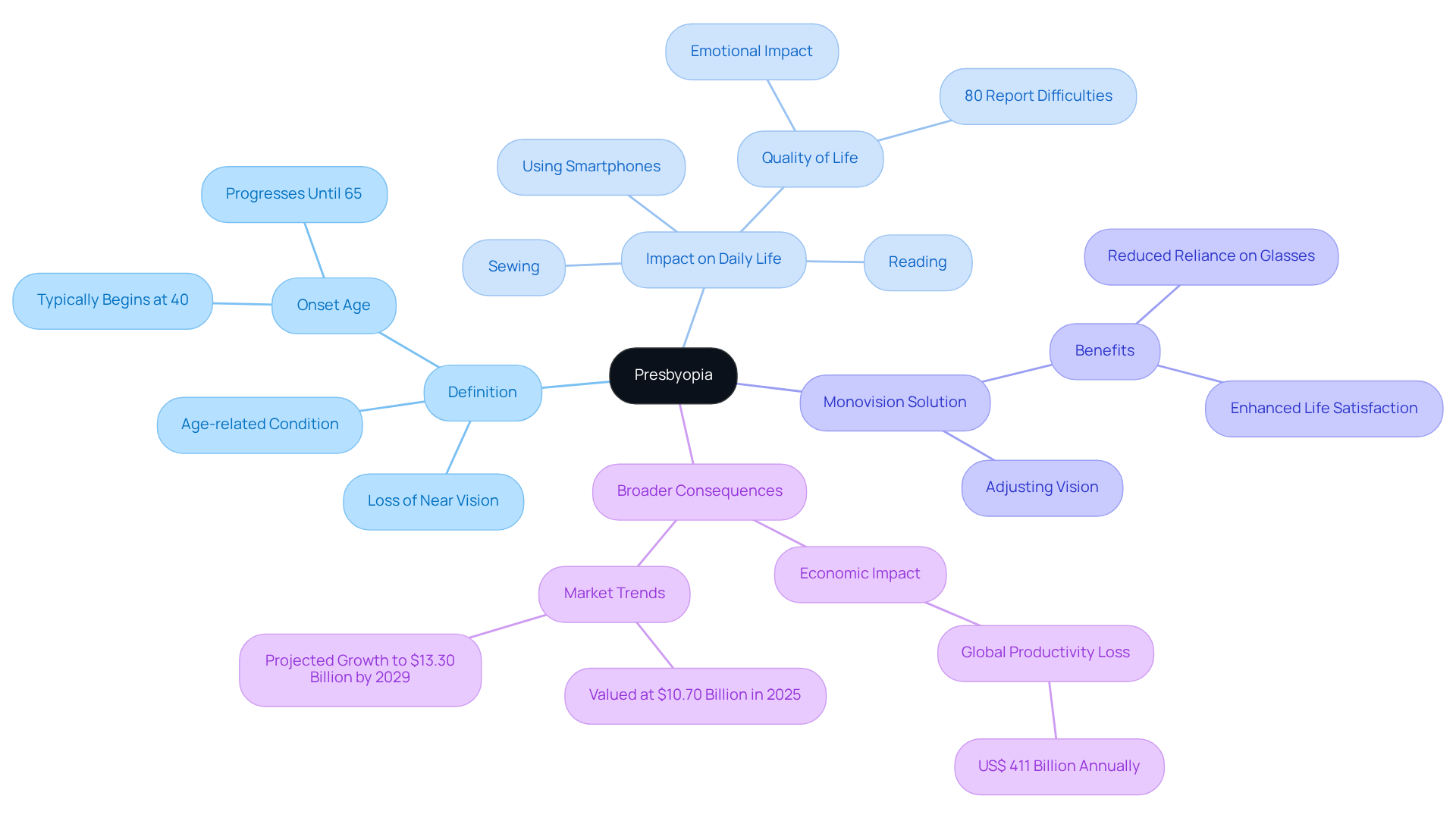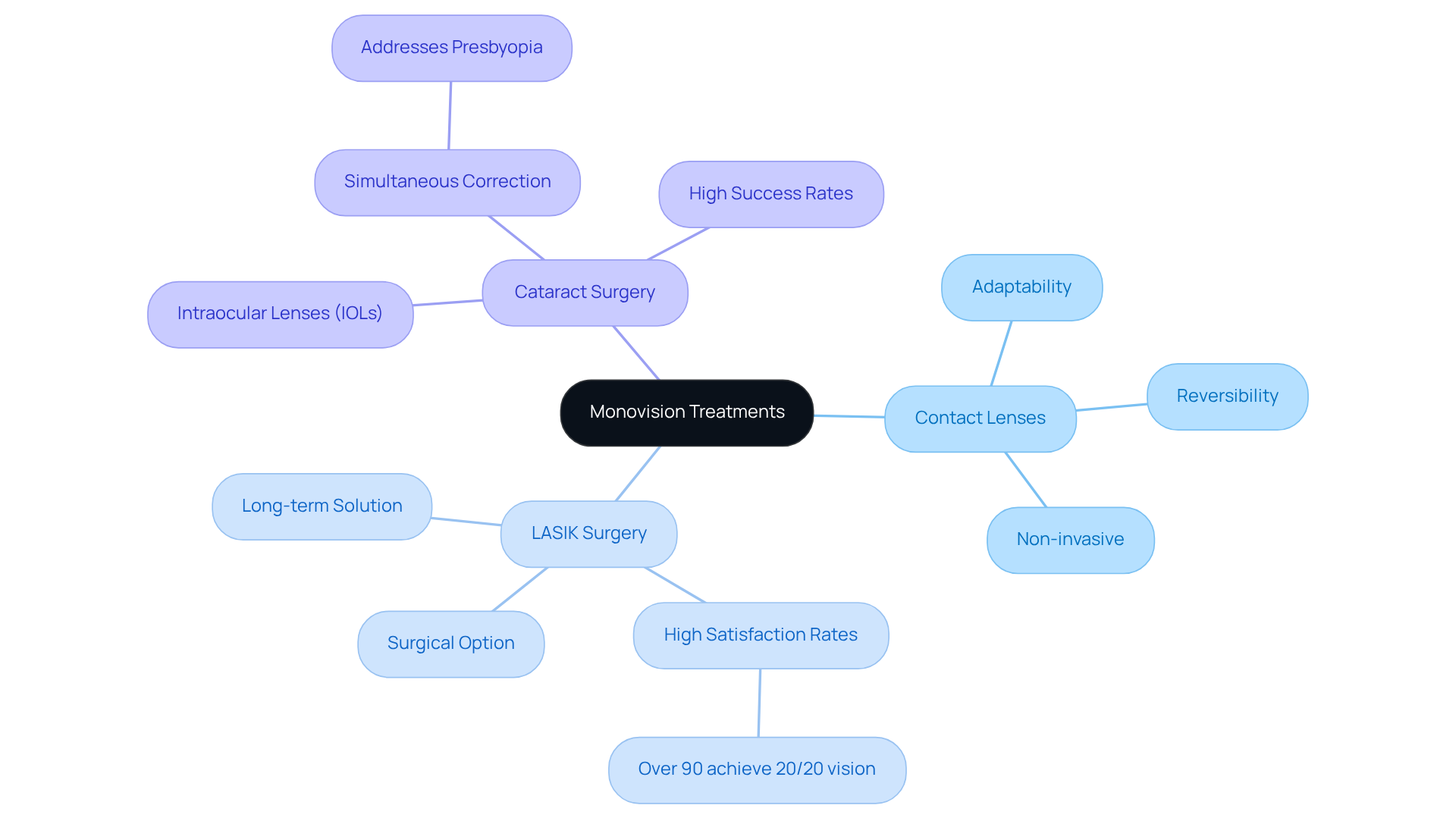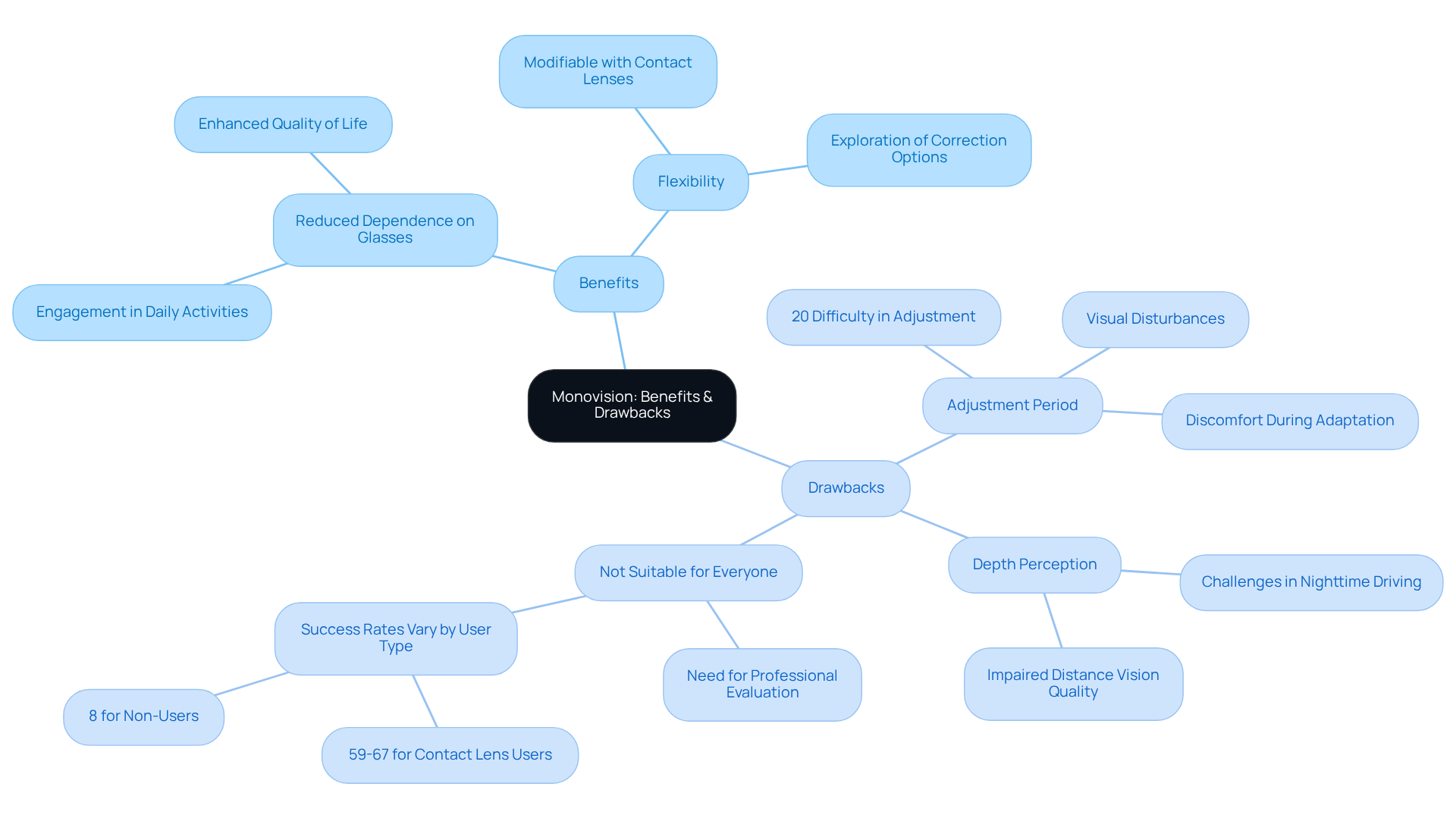Posted by: Northwest Eye in General on July 21, 2025
Overview
Monovision plays a vital role in vision correction, offering a compassionate solution for those grappling with presbyopia. We understand that achieving clear vision at both near and far distances can be challenging, especially without the reliance on glasses. This article explores various methods of implementation, such as:
- contact lenses
- LASIK surgery
Emphasizing how these techniques can significantly enhance daily life for individuals facing age-related vision changes. It’s common to feel apprehensive about these options, but rest assured, they are designed to support you in regaining your clarity and confidence.
Introduction
Monovision is a transformative technique in vision correction that addresses the common challenges of presbyopia, a condition affecting millions as they age. We understand that as you navigate this change, it can feel overwhelming. By strategically adjusting one eye for distance and the other for near vision, this approach not only enhances visual clarity but also liberates individuals from the constant reliance on reading glasses.
However, it’s common to feel uncertain about this innovative solution. The journey to optimal vision through monovision raises intriguing questions about adaptability and the balance between convenience and potential drawbacks. How can you weigh the benefits against the challenges it presents? We are here to help you through this process.
Define Monovision: An Overview of the Technique
Monovision is a specific sight correction technique designed for individuals dealing with presbyopia, a prevalent condition that usually starts to impact people over 40 years of age. We understand that this condition can lead to due to the natural aging process of the eye. In single-eye correction, one eye—usually the dominant one—is adjusted for distance, while the other eye is modified for close-up focus. This dual correction allows individuals to achieve clear vision at both distances without relying on bifocals or reading glasses.
At Northwest Eye, our presbyopia package enhances the experience of monovision by utilizing advanced multifocal lens technologies, including accommodating and extended depth of focus lenses. These specialty lenses help reduce reliance on glasses across various focal ranges—near, far, and intermediate. Our comprehensive approach includes advanced diagnostic technology and testing, ensuring precise measurements and customized solutions for each individual. Various methods can be utilized to implement monovision, including contact lenses, LASIK surgery, or intraocular lenses (IOLs) during cataract surgery. This technique is designed to create a functional balance between the two eyes, enabling the brain to adapt and utilize the best image from each eye for different tasks. It’s common to feel concerned about these changes, especially since studies indicate that approximately 80% of individuals aged 45-55 in North America are estimated to have presbyopia, highlighting the widespread need for effective vision correction solutions.
Recent advancements in one-vision methods, particularly those included in our presbyopia package, have significantly improved outcomes for individuals, with many reporting high satisfaction rates. Our use of the LENSAR™ Laser Surgical System and the innovative Light Adjustable Lens (LAL) allows for a highly customizable approach, enabling patients to trial their preferred focal point correction before finalizing their prescription. As the prevalence of presbyopia continues to rise, projected to impact over 2.1 billion people worldwide by 2030, a single-vision approach stands out as a viable solution for enhancing quality of life and visual function in this demographic. We are here to help you through this process, ensuring that you feel supported every step of the way.

Contextualize Monovision: Addressing Presbyopia and Vision Needs
Presbyopia is an unavoidable part of aging that many of us begin to notice in our 40s or 50s. As the lens of the eye becomes less flexible, it can become progressively harder to focus on close objects. We understand how this condition can such as reading, sewing, or using smartphones, significantly affecting your quality of life.
Monovision provides a practical solution for individuals seeking to reduce their reliance on reading glasses or bifocals. By adjusting one eye for distance sight and the other for close vision, this technique allows you to experience effective vision for a range of activities. This approach is especially advantageous for active individuals who prefer not to wear glasses or contact lenses during their daily routines.
It’s common to feel frustrated, as studies indicate that 80% of presbyopic patients report difficulties with near-vision activities. This underscores the demand for effective alternatives such as single-vision lenses. Monovision can enhance your overall life satisfaction by improving your visual capabilities without the need for constant eyewear, allowing you to engage more fully in your activities.
As noted by the Mayo Clinic, “presbyopia typically begins in your 40s and can continue to progress up until about age 65,” highlighting the age-related nature of this condition. Moreover, the worldwide productivity decrease resulting from sight impairment, including uncorrected presbyopia, is around US$ 411 billion annually, showcasing the broader consequences of this prevalent issue. We are here to help you through this process and support you in finding the best solutions for your vision needs.

Explore Types of Monovision Treatments: Options and Characteristics
Monovision can be achieved through several methods, each thoughtfully designed to meet your unique needs:
- Contact Lenses: This method involves prescribing one lens for distance and another for close-up vision. It offers adaptability and reversibility, making it a popular choice for many due to its non-invasive nature and ease of adjustment. We understand that flexibility is important in your journey towards better vision.
- LASIK Surgery: Monovision is a surgical option in LASIK that corrects one eye for distance and the other for close sight. This method is ideal for individuals seeking a long-term solution and who feel comfortable with the surgical process. Research shows that LASIK recipients often report high satisfaction levels, with over 90% achieving 20/20 vision or better after the procedure. It’s common to feel apprehensive about surgery, but many find the results to be life-changing.
- Cataract Surgery: During cataract surgery, surgeons can implant intraocular lenses (IOLs) designed for monovision, providing distinct focal points for each eye. This option is especially beneficial for individuals with presbyopia undergoing cataract surgery, as it addresses both conditions simultaneously. We are here to help you navigate this option if it aligns with your needs.
Each of these alternatives comes with its own unique advantages and possible disadvantages. Your selection will often depend on your lifestyle, preferences, and specific eyesight needs. We encourage you to engage in appropriate individual selection and , as these are essential for achieving optimal outcomes. Remember, you are not alone in this journey; we are here to support you every step of the way.

Evaluate Benefits and Drawbacks of Monovision: Making an Informed Choice
Patients seeking vision correction can benefit from several advantages offered by monovision.
- Reduced Dependence on Glasses: Many individuals discover they can engage in daily activities without relying on reading glasses or bifocals, enhancing both convenience and comfort. By enabling sharp sight at both near and far distances, monovision can significantly enhance the quality of life and overall satisfaction in daily activities.
- Flexibility: Monovision can be modified or undone, especially when using contact lenses, allowing individuals to explore their correction options.
However, we understand that potential drawbacks should be carefully considered:
- Adjustment Period: It’s common to feel some discomfort as you adapt to the differing vision between your eyes. This adjustment period typically lasts one to two weeks, during which some may experience visual disturbances. Notably, around 20% of individuals may find it challenging to adjust to a single vision.
- Depth Perception: Depth perception can be affected by monovision, making activities such as nighttime driving or sports more challenging. While single vision can effectively eliminate the need for reading glasses, it may , particularly in dim lighting. Research indicates a significant decrease in binocular contrast sensitivity at higher spatial frequencies when using a single-vision approach.
- Not Suitable for Everyone: We recognize that not all patients are ideal candidates for this vision correction method. A thorough evaluation by an eye care professional is essential to determine suitability, as factors like visual dominance and stereo acuity can influence outcomes. Success rates for single-vision correction vary, with approximately 59-67% for pre-existing contact lens users and only 8% for non-users.
Ultimately, the decision to pursue a single vision should be made in consultation with your eye care provider, considering your personal lifestyle needs and visual requirements. We are here to help you through this process. Rates of patient satisfaction for monovision are generally high, with approximately 80% of individuals reporting positive experiences, although some may face challenges in adaptation.

Conclusion
Monovision represents a transformative approach to vision correction, especially for those grappling with presbyopia. By utilizing a dual-focus technique—adjusting one eye for distance and the other for near vision—monovision offers an effective alternative to traditional bifocals or reading glasses. This method not only enhances visual clarity across various distances but also significantly boosts the quality of life for many individuals, allowing them to engage fully in daily activities without the constant need for eyewear.
We understand that exploring treatment options can feel overwhelming. Throughout this article, we have explored key aspects of monovision, including its definition, various treatment options available—such as contact lenses, LASIK, and intraocular lenses—and the benefits and drawbacks associated with this technique. Many patients experience reduced dependence on glasses and report high satisfaction rates. However, it’s common to feel concerned about potential challenges, such as the adjustment period and effects on depth perception. This emphasizes the necessity of personalized consultations with eye care professionals.
Ultimately, monovision stands out as a viable solution for enhancing vision in those affected by presbyopia, particularly as the prevalence of this condition continues to rise. We encourage individuals to explore their options, engage in thorough evaluations, and consider how monovision could fit into their lifestyle. Embracing this innovative approach may not only improve visual function but also empower individuals to reclaim their daily activities with confidence and clarity.
Frequently Asked Questions
What is monovision?
Monovision is a sight correction technique designed for individuals with presbyopia, a condition that typically affects people over 40 years of age, making it difficult to focus on nearby objects. It involves adjusting one eye for distance vision and the other for close-up focus, allowing clear vision at both distances without the need for bifocals or reading glasses.
How does monovision work?
In monovision, one eye—usually the dominant one—is corrected for distance vision, while the other eye is modified for near vision. This dual correction enables the brain to adapt and use the best image from each eye for different tasks.
What technologies are used in monovision correction?
At Northwest Eye, advanced multifocal lens technologies are utilized in the presbyopia package, including accommodating and extended depth of focus lenses. These specialty lenses help reduce reliance on glasses across various focal ranges—near, far, and intermediate.
What methods can be used to implement monovision?
Monovision can be implemented through various methods, including contact lenses, LASIK surgery, or intraocular lenses (IOLs) during cataract surgery.
What advancements have been made in monovision techniques?
Recent advancements, such as the LENSAR™ Laser Surgical System and the Light Adjustable Lens (LAL), have improved outcomes for individuals using monovision. These technologies allow for a highly customizable approach and enable patients to trial their preferred focal point correction before finalizing their prescription.
Why is presbyopia a significant concern?
Presbyopia is a widespread condition, with approximately 80% of individuals aged 45-55 in North America affected. It is projected to impact over 2.1 billion people worldwide by 2030, highlighting the need for effective vision correction solutions.
What support is available for individuals considering monovision?
Northwest Eye offers comprehensive support throughout the monovision process, ensuring that individuals feel supported every step of the way in achieving their vision correction goals.






